Democrats Set Lineup For First Debates
The lineups for the first Democratic debate of the 2020 season are set but some candidates are likely to be unhappy.
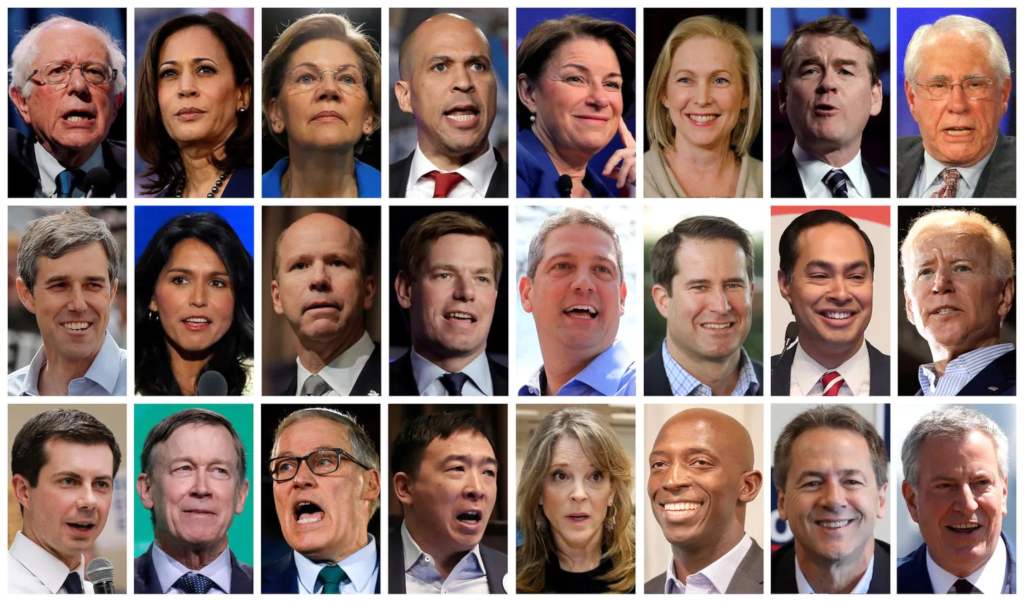
A day after announcing the list of candidates who would be eligible for the twenty-person, two-night opening debate of the 2020 campaign season, yesterday the Democratic National Committee announced which candidates would appear on which night, setting up some interesting lineups and interesting opportunities:
Two nights, four hours, so, so many candidates: the first Democratic presidential debates will be like nothing we’ve ever seen. A former vice president on stage with a self-help author. Three female candidates on one night, three female candidates the next — more than have ever been on the debate stage at once. A 37-year-old squaring off against two septuagenarians.
With Friday’s announcement of the lineups for the debates, set for June 26 and 27, the political stakes and intriguing subplots of the 2020 Democratic primary race came into sharper focus. Candidates, strategists and party officials quickly began analyzing the lineups: Is it better to debate on the first night, even if most of the top-tier candidates are on the second night? Or is it better to debate on the second night and try to draw blood against one of those top candidates?
The first night will be Senator Elizabeth Warren’s to lose, as she faces off against nine lower-polling candidates desperate for breakout moments. But the second night is potentially more consequential, a showdown among four of the biggest names in the 2020 presidential race: Biden, Sanders, Buttigieg, Harris.
Former Vice President Joseph R. Biden Jr. and Senator Bernie Sanders of Vermont will share a stage for the first time — an encounter likely to pose some risk to both. The two men, who’ve been eager to turn the overstuffed 23-candidate primary into a race against President Trump, will make the case for very different ideologies — and try to undercut each other’s — but they also could look like figures from the past while on the same stage with Senator Kamala Harris of California and Mayor Pete Buttigieg of South Bend, Ind.
The lineups were randomly decided in a process engineered by the Democratic National Committee to avoid clustering the top-tier candidates in a single night. But Friday’s sorting drew criticism because the second night ended up including Democrats with far higher polling numbers, on average, than those set to debate the first night.
Some of those selected for the second night seemed particularly excited, spinning random placement as a victory.
“The debates are the first chance for voters across the country to tune in and compare the ideas of the contenders, and I’m honored to have the opportunity,” said Senator Kirsten Gillibrand of New York, who is behind in the polls and fund-raising but could benefit from being in the second debate, which will likely draw a sizable viewership given the top-tier candidates on stage.
Faiz Shakir, the campaign manager for Mr. Sanders, said: “This is a terrific lineup because there will be a real debate over the key set of choices in this Democratic primary.”
The stakes are especially high for candidates like Senators Amy Klobuchar of Minnesota and Cory Booker of New Jersey and former Representative Beto O’Rourke of Texas, who all entered the race with political promise but have struggled to catch fire with voters. The three will vie for airtime in the first debate against candidates who have little momentum, like Mayor Bill de Blasio of New York, as well as against Ms. Warren, who has edged ahead of her rivals in part because of the policy substance of her campaign.
Yet Ms. Warren faces challenges too. Her placement offers a larger share of the spotlight, a chance to soak up extra time on the biggest night yet of the campaign. But it also means she will not get a chance to contrast herself with her top rivals — with, say, Mr. Biden and the credit card industry — and that if anyone on the first night wants to punch up at a top-tier candidate, they will be taking aim at her.
Faiz Shakir, the campaign manager for Mr. Sanders, said: “This is a terrific lineup because there will be a real debate over the key set of choices in this Democratic primary.”
The stakes are especially high for candidates like Senators Amy Klobuchar of Minnesota and Cory Booker of New Jersey and former Representative Beto O’Rourke of Texas, who all entered the race with political promise but have struggled to catch fire with voters. The three will vie for airtime in the first debate against candidates who have little momentum, like Mayor Bill de Blasio of New York, as well as against Ms. Warren, who has edged ahead of her rivals in part because of the policy substance of her campaign.
Yet Ms. Warren faces challenges too. Her placement offers a larger share of the spotlight, a chance to soak up extra time on the biggest night yet of the campaign. But it also means she will not get a chance to contrast herself with her top rivals — with, say, Mr. Biden and the credit card industry — and that if anyone on the first night wants to punch up at a top-tier candidate, they will be taking aim at her.
Mr. Buttigieg, who has climbed out of obscurity and risen in the polls, will have a national stage to showcase his generational change argument while standing aside Mr. Biden and Mr. Sanders — who are each nearly 40 years older than he is.
Ms. Harris, who will face off against those three men and six other candidates, has an opportunity to present her contrasting vision of electability based on a multiracial coalition against Mr. Biden’s argument that he can win back white male Rust Belt voters who cast ballots for Mr. Trump.
The lineups for the two nights are as follows, with the names in alphabetical order. I’ve highlighted in both lists those candidates who are above 2% in the RealClearPolitics national polling average.
Night One, June 26th:
- New Jersey Senator Cory Booker
- Former HUD Secretary Julian Castro
- New York City Mayor Bill DeBlasio
- Maryland Congressman John Delaney
- Hawaii Congresswoman Tulsi Gabbard
- Washington Governor Jay Inslee
- Minnesota Senator Amy Klobuchar
- Former Texas Congressman Beto O’Rourke
- Ohio Congressman Tim Ryan
- Massachusetts Senator Elizabeth Warren
Night Two June 27th:
- Colorado Senator Michael Bennet
- Former Vice-President Joe Biden
- South Bend Mayor Pete Buttigieg
- New York Senator Kristen Gillibrand
- California Senator Kamala Harris
- Former Colorado Governor John Hickenlooper
- Vermont Senator Bernie Sanders
- California Congressman Eric Swalwell
- Political Activist Marianne Williamson
- Businessman Andrew Yang
My first thought in looking at these two lists is that Elizabeth Warren ended up being the luckiest of all the major candidates, but the lineup also presents her with some downside risk. The advantages are fairly easy to see. Not only will she have the stage to herself among the”top tier” candidates but she also gets the first night, which will likely have draw a good-sized audience simple because it will be the first time that most Democrats will get a chance to see the candidates together on stage for an extended period of time. This will give her an opportunity to expand on the strategy she’s been following for the past several months of emphasizing policy proposals, a strategy that seems to be doing well for her if the polls are any indication.
The lineup also has some downside for Warren, though. The first is that she’ll be deprived of the opportunity to contrast herself directly with her chief rivals, Vice-President Biden and fellow Senator Bernie Sanders. Second, the fact that she will be sharing the stage with so many candidates who will have the incentive to make marks of their own in an effort to climb up the polls and attract support in both the early primary states and across the nation as a whole. This will especially be true for those candidates near the bottom of the polls whose campaigns are struggling and who may not qualify for future debates beyond this one and the one scheduled for the end of July, eligibility for which will be determined by using essentially the same criteria as the first debate.
The second night of the debate arguably has the more interesting lineup, something that could end up drawing in more viewers than the first night. Not only will we get to see former Vice-President Biden and Senator Sanders, who have been at the top of the polls for months now, but we’ll also get to see two other candidates that have drawn national attention at this early stage of the race, Pete Buttigieg and Kamala Harris. The risks and rewards for all four of these candidates are, I think, as self-evident as those for Warren on the first night, and the same goes for the risks that each candidate will face. This will be especially true for Biden, who has limited most of his early campaign appearances to prepared speeches that limit the chances that he’ll speak extemporaneously and inadvertently put his foot in his mouth. Sanders will enter the debate perhaps the best prepared since he shared the national debate stage with Hillary Clinton several times during the race for the 2016 nomination. Additionally, both Sanders and Biden will be in the sights of the lower-ranking candidates who will be looking at this debate as an opportunity to build momentum for their fledgling campaigns.
Reacting to the lineup, Nathaniel Rakich and Geoffrey Skelly at FiveThirtyEight argue that while the Democrats tried to use a process that avoided a lopsided debate format, that’s exactly what they ended up with. While one can make that argument about both nights, with Warren obviously dominating the first night and the Biden-Sanders-Buttigieg-Harris showdown obviously being the focus of the second night, I’m not sure what could have been done to make the process any fairer than the random draw method that was used to set the lineup. Had they group all the frontrunners into one night, they would have been accused by those who made the other night of deliberately stacking the deck against them, for example. Additionally, the lower tier candidates on both nights would have argued that they would be overshadowed by the frontrunners, especially if they don’t end up getting a lot of airtime. Given that, the DNC seems to have done the best they could under the circumstances. Now it will be up to the candidates to prove themselves.

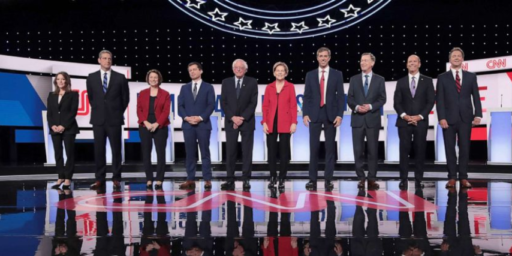
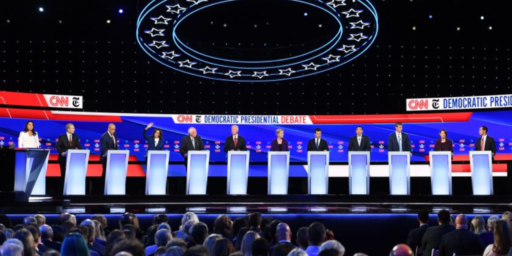
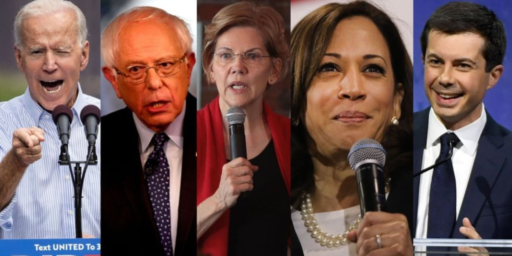
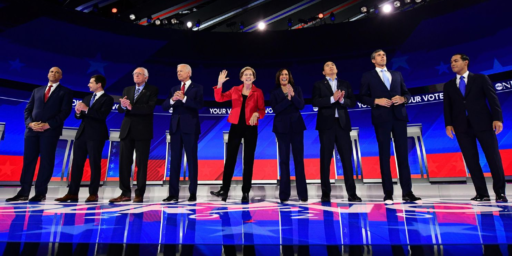
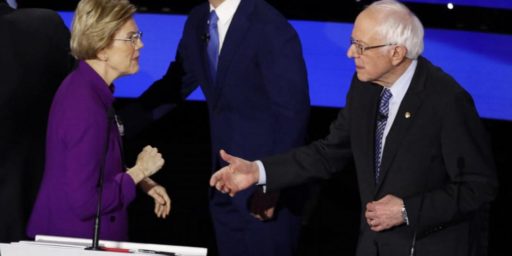
Doug,
On the first night, Klobuchar is above 2% as well.
Doug, what does the picture at the top of this post represent? It includes Mark Zuckerberg and Al Franken so I don’t think it’s a composite photo of the Democratic presidential candidates.
@Moosebreath:
Not in the RCP national average.
@Dave Schuler:
It is the most recently available image showing all of the candidates in the race. And, yes, it also happens to include some people who have flirted with the idea of getting in the race. I have not seen a more up-to-date version.
@Doug Mataconis: you’re using two different images again. The one of the top of this page has 24 candidates, the one on the front page has 27.
@Dave Schuler: @Teve: Picky, picky! Give it a rest, guys! While the pictures are not accurate in a documentary sense, they accurately and forcefully convey the idea that there are more people running than anyone could give a flying fwck about.
At least Howard Schultz is suspending his campaign, in the same way I’m suspending my attempt to do a standing quadruple backflip.
5% as the top-tier threshold, same random pattern after that.
They were trying to avoid the kiddie table from the Republican debates in 2016, but they still managed to come up with a very lopsided lineup.
Oh well. They can adjust it in 2023. I assume that 20 candidates for each open nomination is just the new normal.